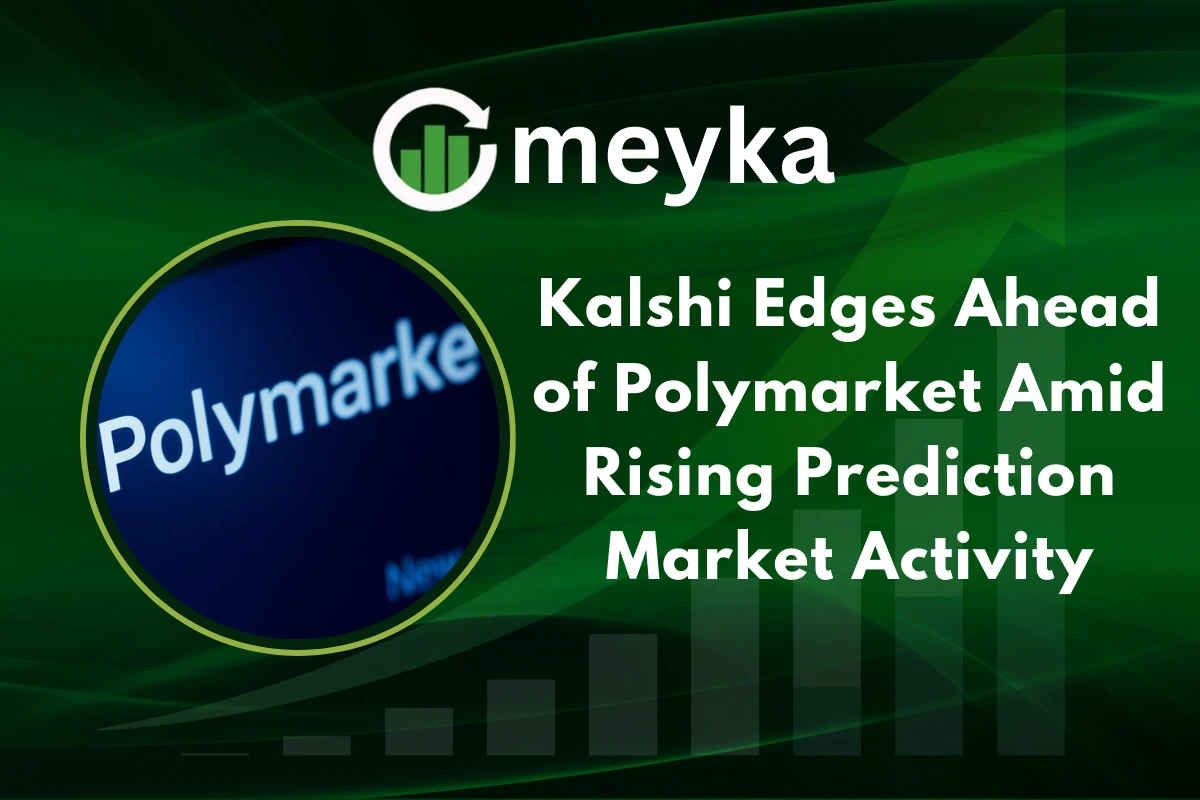Kalshi Edges Ahead of Polymarket Amid Rising Prediction Market Activity
Kalshi has taken a lead in the on-chain prediction market race, posting higher weekly trading volumes than Polymarket for several weeks running. The surge is driven by sports markets, new product features, and distribution partners that route retail flow to Kalshi’s regulated U.S. venue.
At the same time, Polymarket is fighting back with yield incentives for long-term bettors, keeping the rivalry hot. Both platforms now shape how traders view prediction markets as a growing, tradable corner of financial and sports betting activity.
Why is Kalshi gaining more traction than Polymarket? Kalshi’s U.S. regulatory footing, sports betting product expansion, and distribution deals have created large, fast-turnover volume that Polymarket’s long-term structure does not match.
Kalshi’s Volume Surge and Market Dynamics
Recent volume numbers
Kalshi posted blockbuster weekly volumes recently, including a $728 million trading week noted by market reports, a level close to its 2024 election peak. That pushed Kalshi ahead by volume for a third straight week.
Data shows sports markets now account for a very large share of Kalshi’s activity, changing the profile of market flow from political to athletic events.
What’s driving the spike
The platform has leaned into sports betting style markets, launching NFL and college football markets and prop bets that attract high-frequency traders.
Industry observers say newer prop markets and partnership distribution, notably via broker and app integrations, turbocharge liquidity and turnover. Robinhood’s prediction hub and in-app routes have funneled meaningful volume to Kalshi.
Is sports the whole story? No, but sports betting has become the single largest growth lever, accounting for the majority of recent trading activity.
Kalshi vs Polymarket: Product and Regulatory Differences
Kalshi’s regulatory advantage
Kalshi operates under U.S. regulatory frameworks that allow it to offer certain event contracts broadly within the country.
That licensing creates easier access through mainstream app stores and financial partners, and it makes Kalshi legally available to U.S. retail users without VPNs or crypto workarounds. This regulatory clarity is a key competitive advantage.
Polymarket’s approach and yield play
Polymarket remains a major global player, but its structure historically leaned more on longer-term political markets and crypto-native users. Recently, Polymarket introduced a 4% yield on select long-horizon political markets to incentivize hold-to-maturity positions and increase open interest.
That yield is designed to attract patient capital and stabilize pricing in long-term markets.
What makes them different for a user? Kalshi today often suits short-duration, event-driven wagering like sports props, while Polymarket appeals to long-horizon political traders and yield-seeking participants.
Product Innovation: Sports Markets, Props, and Yield
Prop bets and NFL markets
Kalshi expanded into proposition-style markets, including in-game or player-specific wagers. These markets increase turnover because they reset frequently and create many micro-events per game. Kalshi added prop bets in August and then rolled out more football markets, which analysts say account for over 70% of the platform’s trading volume in some windows.
That product mix resembles sportsbook mechanics more than traditional political prediction markets.
Polymarket’s yield experiment
Polymarket’s 4% incentive on certain long-term political and geopolitical contracts is an experiment in liquidity retention. By paying a variable yield, funded through the platform’s treasury, Polymarket aims to encourage bettors to hold positions instead of flipping, thereby increasing open interest and fee capture over time.
It’s a clear counter to Kalshi’s volume advantage, and it underscores competition over both traders and capital.
Will yields change platform dynamics? Possibly: yields may pull in more long-term stakers, but they are costly and adjustable, making them a tactical tool rather than a permanent fix.
Distribution and Partnerships: The Growth Levers
App stores, brokers, and routing
Kalshi’s regulated status lets it appear in mainstream channels and partner with retail trading apps. Those distribution paths unlock mass retail flow and lower friction for new users. Robinhood’s hub and other integrations become a multiplier for volume, bringing non-crypto traders onto the platform.
Polymarket’s strategic moves
Polymarket has pursued acquisitions and regulatory steps to enter U.S. markets safely, including buying a regulated exchange and receiving supportive regulatory letters in some cases. These moves aim to grant Polymarket more direct U.S. access, narrowing Kalshi’s regulatory moat over time.
Which channel matters more? Distribution that reduces sign-up friction and sits in users’ daily apps often wins early volume, especially for sports and micro-event markets.
The Broader Prediction Market Opportunity
Prediction markets as an asset class
Prediction markets are evolving into a hybrid product: part financial contract, part betting market, part information market. They appeal to traders who want exposure to real-world outcomes, and to bettors who prefer market-driven pricing.
As markets diversify beyond politics into sports and macro, volume can scale rapidly.
Regulatory and reputational risks
Regulation remains the biggest uncertainty. Kalshi’s U.S. regulatory status is an advantage but also a responsibility. Polymarket’s moves to obtain regulatory standing show the sector’s path toward mainstream legitimacy.
Still, platforms must manage market integrity risks, bot activity, and legal scrutiny as they grow.
Are prediction markets sustainable? They can be, if platforms balance product innovation, regulatory compliance, and fair-market mechanics to preserve trader trust.
What Analysts and Insiders Say
Industry voices point to sports betting and distribution as decisive factors in Kalshi’s recent lead. Sports betting consultant Dustin Gouker and others note that the land grab for sports markets will intensify as rivals add product features and regulatory access.
Traders and platforms are now experimenting with incentives, product design, and partnerships in real time.
Conclusion: Kalshi’s Outlook and Polymarket’s Response
Kalshi has staked a first-mover advantage in regulated U.S. sports-style prediction markets, and that advantage shows up in recent weekly volumes. Polymarket’s yield program and regulatory steps mean the competition will remain tight.
The sector’s near-term winners will be the platforms that combine product depth, legal clarity, and low-friction distribution. For traders, that means more choice, deeper markets, and evolving opportunities, but also a need to watch for platform-specific risk, rules and terms.
The prediction market story is now about frictionless access and product-market fit, and Kalshi’s recent edge marks a new chapter in that race.
FAQ’S
Kalshi is gaining momentum because it has regulatory approval in the U.S., allowing it to offer legal prediction markets, while Polymarket operates offshore.
Unlike most crypto-based platforms, Kalshi is regulated by the CFTC, which makes it more trustworthy for U.S. traders and investors.
Yes, Kalshi is fully regulated by the Commodity Futures Trading Commission (CFTC), giving it an edge over unregulated competitors.
Kalshi’s surge is driven by new event contracts, such as those tied to elections and sports betting, which attract wider participation.
Experts predict that Kalshi prediction markets 2025 will expand into sports betting and mainstream finance, creating stronger competition with Polymarket.
Disclaimer
This is for information only, not financial advice. Always do your research.






